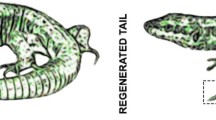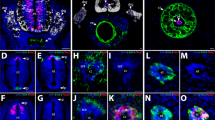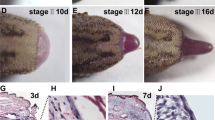Abstract
Many species of lizards are capable of tail regeneration. There has been increased interest in the study of lizard tail regeneration in recent years as it is an amenable regeneration model for amniotes. In this study, Gekko japonicus was used as a model to investigate the initiation of vascularization, innervation and myogenesis during tail regeneration. We found that angiogenesis and axon regeneration occurred almost simultaneously within 4 days post amputation. The results showed that the endothelial cells of the original vasculature proliferated and extended into the blastema as capillary vessels, which inter-connected to form a capillary network. The nerve fibers innervated the regenerated tissue from the original spinal cord and dorsal root ganglia, and the fiber bundles increased during 14 days. Regenerating muscle tissues emerged 2 weeks after amputation. PAX3 and PAX7 expression were detected during myogenesis, with PAX7 showing a continuous increase in expression from day 3 until the day 14, whereas PAX3 reached a peak level on day 10 day post amputation, and then declined quickly to level as normal control on day 14. PCNA and PAX3 double-positive satellite cells were observed in the original rostral tissues, indicating the involvement of satellite cell proliferation during tail regeneration. Taken together, these data suggest that tail regeneration in Gekko japonicus involved rapid angiogenesis from the beginning to the day 10 and followed by capillary remodeling. The innervation of regenerated tail was significant on day 4 and increased gradually during regeneration, while the regenerated muscle tissues was obvious on day 14 after amputation.









Similar content being viewed by others
References
Alibardi L (2014) Histochemical, biochemical and cell biological aspects of tail regeneration in lizard, an amniote model for studies on tissue regeneration. Prog Histochem Cytochem 48(4):143–244. https://doi.org/10.1016/j.proghi.2013.12.001
Alibardi L, Miolo V (1990) Fine observation on nerves colonizing the regenerating tail of the lizard Podarcis sicula. Histol Histopathol 5(4):387–396
Bely AE, Nyberg KG (2010) Evolution of animal regeneration: re-emergence of a field. Trends Ecol Evol 25(3):161–170. https://doi.org/10.1016/j.tree.2009.08.005
Comai G, Tajbakhsh S (2014) Molecular and cellular regulation of skeletal myogenesis. Curr Top Dev Biol 110:1–73. https://doi.org/10.1016/b978-0-12-405943-6.00001-4
Crist CG, Montarras D, Pallafacchina G, Rocancourt D, Cumano A, Conway SJ, Buckingham M (2009) Muscle stem cell behavior is modified by microRNA-27 regulation of Pax3 expression. Proc Natl Acad Sci USA 106(32):13383–13387. https://doi.org/10.1073/pnas.0900210106
Delorme SL, Lungu IM, Vickaryous MK (2012) Scar-free wound healing and regeneration following tail loss in the leopard gecko, Eublepharis macularius. Anat Record (hoboken, NJ: 2007) 295(10):1575–1595. https://doi.org/10.1002/ar.22490
Fisher RE, Geiger LA, Stroik LK, Hutchins ED, George RM, Denardo DF, Kusumi K, Rawls JA, Wilson-Rawls J (2012) A histological comparison of the original and regenerated tail in the green anole, Anolis carolinensis. Anat Record (hoboken, NJ: 2007) 295(10):1609–1619. https://doi.org/10.1002/ar.22537
Gilbert EA, Payne SL, Vickaryous MK (2013) The anatomy and histology of caudal autotomy and regeneration in lizards. Physiol Biochem Zool PBZ 86(6):631–644. https://doi.org/10.1086/673889
Haas BJ, Whited JL (2017) Advances in decoding axolotl limb regeneration. Trends Genet TIG 33(8):553–565. https://doi.org/10.1016/j.tig.2017.05.006
Hutchins ED, Markov GJ, Eckalbar WL, George RM, King JM, Tokuyama MA, Geiger LA, Emmert N, Ammar MJ, Allen AN, Siniard AL, Corneveaux JJ, Fisher RE, Wade J, DeNardo DF, Rawls JA, Huentelman MJ, Wilson-Rawls J, Kusumi K (2014) Transcriptomic analysis of tail regeneration in the lizard Anolis carolinensis reveals activation of conserved vertebrate developmental and repair mechanisms. PLoS ONE 9(8):e105004. https://doi.org/10.1371/journal.pone.0105004
Jiang M, Gu X, Feng X, Fan Z, Ding F, Liu Y (2009) The molecular characterization of the brain protein 44-like (Brp44l) gene of Gekko japonicus and its expression changes in spinal cord after tail amputation. Mol Biol Rep 36(2):215–220. https://doi.org/10.1007/s11033-007-9169-0
Kahn EB, Simpson SB Jr (1974) Satellite cells in mature, uninjured skeletal muscle of the lizard tail. Dev Biol 37(1):219–223. https://doi.org/10.1016/0012-1606(74)90181-x
Kang JS, Krauss RS (2010) Muscle stem cells in developmental and regenerative myogenesis. Curr Opin Clin Nutr Metab Care 13(3):243–248. https://doi.org/10.1097/MCO.0b013e328336ea98
Londono R, Wenzhong W, Wang B, Tuan RS, Lozito TP (2017) Cartilage and muscle cell fate and origins during lizard tail regeneration. Front Bioeng Biotechnol 5:70. https://doi.org/10.3389/fbioe.2017.00070
Lozito TP, Tuan RS (2015) Lizard tail regeneration: regulation of two distinct cartilage regions by Indian hedgehog. Dev Biol 399(2):249–262. https://doi.org/10.1016/j.ydbio.2014.12.036
McLean KE, Vickaryous MK (2011) A novel amniote model of epimorphic regeneration: the leopard gecko, Eublepharis Macularius. BMC Dev Biol 11:50. https://doi.org/10.1186/1471-213x-11-50
Morrison JI, Lööf S, He P, Simon A (2006) Salamander limb regeneration involves the activation of a multipotent skeletal muscle satellite cell population. J Cell Biol 172(3):433–440. https://doi.org/10.1083/jcb.200509011
Nacu E, Tanaka EM (2011) Limb regeneration: a new development? Annu Rev Cell Dev Biol 27:409–440. https://doi.org/10.1146/annurev-cellbio-092910-154115
Nowoshilow S, Schloissnig S, Fei JF, Dahl A, Pang AWC, Pippel M, Winkler S, Hastie AR, Young G, Roscito JG, Falcon F, Knapp D, Powell S, Cruz A, Cao H, Habermann B, Hiller M, Tanaka EM, Myers EW (2018) The axolotl genome and the evolution of key tissue formation regulators. Nature 554(7690):50–55. https://doi.org/10.1038/nature25458
Palade J, Djordjevic D, Hutchins ED, George RM, Cornelius JA, Rawls A, Ho JWK, Kusumi K, Wilson-Rawls J (2018) Identification of satellite cells from anole lizard skeletal muscle and demonstration of expanded musculoskeletal potential. Dev Biol 433(2):344–356. https://doi.org/10.1016/j.ydbio.2017.08.037
Payne SL, Peacock HM, Vickaryous MK (2017) Blood vessel formation during tail regeneration in the leopard gecko (Eublepharis macularius): the blastema is not avascular. J Morphol 278(3):380–389. https://doi.org/10.1002/jmor.20648
Pfefferli C, Jaźwińska A (2015) The art of fin regeneration in zebrafish. Regeneration (oxford, England) 2(2):72–83. https://doi.org/10.1002/reg2.33
Rageh MA, Mendenhall L, Moussad EE, Abbey SE, Mescher AL, Tassava RA (2002) Vasculature in pre-blastema and nerve-dependent blastema stages of regenerating forelimbs of the adult newt, Notophthalmus viridescens. J Exp Zool 292(3):255–266. https://doi.org/10.1002/jez.10015
Rakocevic J, Orlic D, Mitrovic-Ajtic O, Tomasevic M, Dobric M, Zlatic N, Milasinovic D, Stankovic G, Ostojić M, Labudovic-Borovic M (2017) Endothelial cell markers from clinician’s perspective. Exp Mol Pathol 102(2):303–313. https://doi.org/10.1016/j.yexmp.2017.02.005
Sandoval-Guzmán T, Wang H, Khattak S, Schuez M, Roensch K, Nacu E, Tazaki A, Joven A, Tanaka EM, Simon A (2014) Fundamental differences in dedifferentiation and stem cell recruitment during skeletal muscle regeneration in two salamander species. Cell Stem Cell 14(2):174–187. https://doi.org/10.1016/j.stem.2013.11.007
Semenza GL (2007) Vasculogenesis, angiogenesis, and arteriogenesis: mechanisms of blood vessel formation and remodeling. J Cell Biochem 102(4):840–847. https://doi.org/10.1002/jcb.21523
Simpson SB Jr. (1970) Studies on regeneration of the lizard’s tail. Am Zool 10(2):157–165. https://doi.org/10.1093/icb/10.2.157
Stocum DL, Cameron JA (2011) Looking proximally and distally: 100 years of limb regeneration and beyond. Dev Dyn off Publ Am Assoc Anat 240(5):943–968. https://doi.org/10.1002/dvdy.22553
Tokuyama MA, Xu C, Fisher RE, Wilson-Rawls J, Kusumi K, Newbern JM (2018) Developmental and adult-specific processes contribute to de novo neuromuscular regeneration in the lizard tail. Dev Biol 433(2):287–296. https://doi.org/10.1016/j.ydbio.2017.10.003
Xu M, Wang T, Li W, Wang Y, Xu Y, Mao Z, Wu R, Liu M, Liu Y (2019) PGE2 facilitates tail regeneration via activation of Wnt signaling in Gekko japonicus. J Mol Histol 50(6):551–562. https://doi.org/10.1007/s10735-019-09847-7
Yokoyama H (2008) Initiation of limb regeneration: the critical steps for regenerative capacity. Dev Growth Differ 50(1):13–22. https://doi.org/10.1111/j.1440-169X.2007.00973.x
Zhou Y, Xu Q, Li D, Zhao L, Wang Y, Liu M, Gu X, Liu Y (2013) Early neurogenesis during caudal spinal cord regeneration in adult Gekko japonicus. J Mol Histol 44(3):291–297. https://doi.org/10.1007/s10735-012-9466-3
Zika JM (1969) A histological study of the regenerative response in a lizard, Anolis carolinensis. J Exp Zool 172(1):1–8. https://doi.org/10.1002/jez.1401720102
Acknowledgements
This work was supported by National Natural Science Foundation of China (Grant No. 31970412, 31472004 and 31071874); Natural science foundation of Jiangsu province (Grant No. BK20191446); the Priority Academic Program Development (PAPD) of Jiangsu Higher Education Institutions.
Author information
Authors and Affiliations
Corresponding authors
Ethics declarations
Conflict of interest
All authors declare no conflict of interest.
Additional information
Publisher's Note
Springer Nature remains neutral with regard to jurisdictional claims in published maps and institutional affiliations.
Supplementary Information
Below is the link to the electronic supplementary material.
10735_2021_10032_MOESM1_ESM.tif
Supplementary figure S1. Morphology of regenerating tail from day 4 to day 14. Hematoxylin and eosin-stained longitudinal sections from regenerates on the 4th (A) 7th (B), 10th (C) and 14th day (D) post amputation. A. On 4th day post amputation, the rostral epaxial (em) and hypaxial (hm) musculature was the predominant tissue, under the healing wound at the amputation plane (dashed line). A clot (cl) is evident at the tip of the regenerate covering a thin layer of wound epithelium. B. By 7th day post amputation the wound epithelium (we) has thickened and completely covered the amputation plane (dashed line). C-D The blastema grew significantly on 10th and 14th day, and blood vessels (bv) were clearly visible in the blastema (bl). The amputation plane is indicated in all figures by the dashed lines. Scale bar represents 200 μm. Supplementary file1 (TIF 22017 kb)
10735_2021_10032_MOESM2_ESM.tif
Supplementary figure S2. Endothelial cell proliferation during tail regeneration. Co-immunolabelling for CD34 (green) and BrdU (white), with Hoechst nuclear staining (blue) revealed proliferating endothelial cells or their progeny were present in both the rostral original tail stump and the distal blastema region on days 10 and 14 (A, C). The enlarged views of boxed area are shown in B, D respectively. The arrows indicate BrdU+/CD34+ proliferating endothelial cells. The dashed lines indicate amputation planes. Scale bars represent 200 μm in A and C, represent 50 μm in B and D. Supplementary file2 (TIF 7026 kb)
10735_2021_10032_MOESM3_ESM.tif
Supplementary figure S3. No evidence for myogenesis in the regenerated tail from days 4 to 12 post amputation. A-C In longitudinal sections stained with myosin heavy chain (MHC) antibody, fragmented muscle fibers were present in the distal end of the tail stump rostral to the amputation plane on the 4th day. B and C show magnified views of the boxed areas in A. The green fluorescence in the clot at the tip of regenerate is artefact (*) D-F. On the 7th day post amputation, blood vessels had penetrated the tissues under the wound epithelium but there was no reactivity for muscle fibers other than in the original epaxial (em) and hypaxial (hm) muscles. E and F show magnified views of the boxed areas in D. G-L. On days 10 and 12 post amputation, blood vessels had clearly penetrated the growing blastema (bl). However, there was no evidence for regenerating muscle cells in the blastema using the MHC antibody. H and I show enlarged views of the boxed areas in G. K and L show enlarged views of the boxed areas in J. The dashed lines indicate amputation planes in each regenerate. Scale bars represent 200 μm in A, D, G and J, and 100 μm in B, C, E, F, H, I, K and L. Supplementary file3 (TIF 14167 kb)
Rights and permissions
About this article
Cite this article
Liu, Z., Huang, S., Xu, M. et al. The vascularization, innervation and myogenesis of early regenerated tail in Gekko japonicus. J Mol Histol 52, 1189–1204 (2021). https://doi.org/10.1007/s10735-021-10032-y
Received:
Accepted:
Published:
Issue Date:
DOI: https://doi.org/10.1007/s10735-021-10032-y




